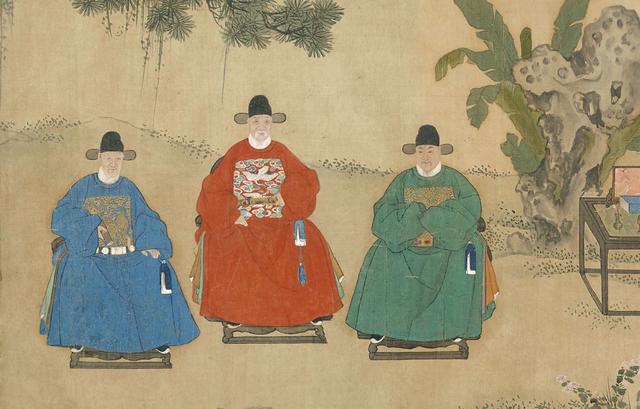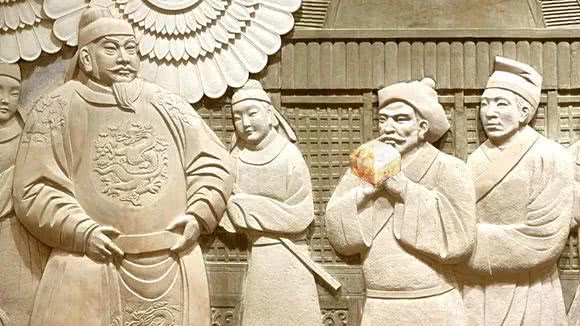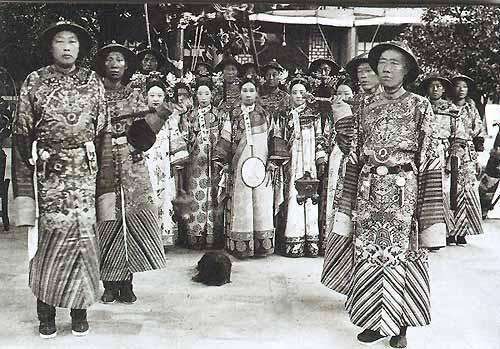Changes of Ming and Qing Empires and Measures Aimed to Intensify Imperial Power
8 min readThe period from 1368 to 1840 was the Ming and Qing dynasties in Chinese history.
At the end of the Yuan Dynasty(1279-1368), the situation of class differences and national contradictions was deteriorating, which triggered large-scale peasant insurgence. In 1368, Zhu Yuanzhang headed a peasant army to pull down Yuan rule, defeat the leaders of other peasant uprisings and establish the Ming Dynasty with its capital in Yingtian (Nanjing, Jiangsu Province).
Emperor Taizu Zhu Yuanzhang and Emperor Chengzu Zhu Di of the Ming Dynasty enforced imperial power by abolishing the prime minister, creating the system of Grand Secretariat and setting up secret services to enforce control over grassrootsthinking and cultural circles. They moved the capital to Beijing during their reign, formulating the basic structure of the Ming Dynasty system of centralized monarchic despotism. At the same time, the rulers of the early Ming Dynasty implemented economic policies to encourage cultivation of wastelands, reduce corvee and taxes, reward those who planted cash crops and lift the social status of the craftsmen, which helped recover and develop the economy. The Yongle Period (1403-1424) of Emperor Zhu Di saw social stability and strong national strength and was another prosperous time in Chinese history.

In the early days of the Wanli Period (1573-1620), Premier Zhang Juzheng reformed the taxation and corvee systems and implemented the Single-Whip Reform tocombine the original land taxes, corvee and incidental taxes into one and levy taxe based on land area. The reform stimulated development of the commodity economy and more than 30 industrial and commercial cities emerged south of the lower reaches ofthe Yangtze River. New changes similar to capitalism in western countries emerged in the production relationship and labor combination in the handicraft workshops, indicating the early emergence of capitalist relationships.
In the late Ming Dynasty, land mergers deteriorated and the peasants were forced out of their homeland, leading to the abandonment of vast lands, which became wasteland. The ruling class was greedy, cruel and corrupt and dispatched a large number of eunuchs to act as mine supervisors and tax levy officers to rob peoplearbitrarily, seriously damaging folk industry and commerce. At the end of the Ming Dynasty, the invasion of the Late Jin and natural disasters over several consecutiv years finally triggered large-scale peasant uprisings that lasted nearly 20 years and involved several millions of people. In March 1644, the insurgent peasant army headed by Li Zicheng occupied Beijing and Emperor Chongzhen committed suicide. The Ming Dynasty came to its end. In April of the same year, the Qing army, which had arrived at Shanhaiguan Pass, summoned Wu Sangui, commander of Ningyuan of the Ming Dynasty, to surrender and beat the insurgent army and moved the capital from Shengjing (Shenyang, Liaoning) to Beijing in September, seizing the supreme dominion of the country.

The Manchu,who established the Ming Dynasty,were a new federation of ethnic groups formed after Nurhachi unified the tribes of Nuzhen during the late Ming Dynasty.Nurhachi proclaimed himself as Khan and established a kingdom named Late Jin.His son Huangtaiji ascended the throne and proclaimed himself emperor in Shengjing and changed the title to Qing.After entering Shanhaiguan Pass,the Qing army seized land on a large scale,forced the poor as their servants and compelledthe residents in southeastern coastal areas to move inward for 30-50 1i.They also forced the Han people to shave their hair and comb plait with the threat of“if you want to live,you must cut your hair;if you keep your hair,you will be killed”t follow the system of the Qing,making it a symbol of the reign of Manchu nobility. The policies of ethnic group oppression and the backwardness of the production relationship implemented in the early Qing Dynasty worsened the social economy,which had been seriously damaged by years of civil war and the trend of evolving into a modern society was interrupted.
The cruel policies implemented in the early Qing Dynasty aroused fierce resistance and the campaigns against the Qing rulers speeded up the conquering ofthe savage conquerors by advanced civilization. The basic crisis of the separationbetween the land and the laborers at the end of the Ming Dynasty was removed with the peasant warfare.A favorable condition was created for policy adjustment for th recovery of economic development in the early Qing Dynasty. During the reigns of Emperor Kangxi, Emperor Yongzheng and Emperor Qianlong, the social economy developed rapidly and reached a new height in the history of China.
The Ming and Qing dynasties saw further strengthened centralism and highly swelling imperial power.

The Six-Department System from the Sui and Tang dynasties remained basically unchanged during the Ming and Qing dynasties, while the Three-Ministry System was adjusted and reformed to further reduce the power of the prime ministers and enforce the power of the emperor.
During the period of Hongwu(1368-1398)of the early Ming Dynasty,the Zhongshu Ministry was cancelled and the post of prime minister was removed too.The emperor was in direct charge of the six departments and handled state affairs in person.ZhuYuanzhang set up Diange Daxueshi to help him handle state affairs and documents and offer consultation.The cabinet system was developed during the Yongle Period(1403-1424).In the early Ming Dynasty,the cabinet had no power in deciding any state affairs independently and was only the assistant of the emperor.But the powe of Daxueshi became increasingly strong and the cabinet head was actually like the prime minister of earlier times.
Emperor Yongzheng of the Qing Dynasty set up the Military Affairs Division. Including military affairs,the Military Affairs Division also took part in discussions on all critical state affairs such as the military and administrative programs,civil and diplomatic affairs,including official promotions,removals and assignments and important case hearings,and drafted orders for the emperor.It was a hub for the emperor to issue orders and handle state affairs.However,the ministers of the Military Affair Division were of lower ranks without dedicated government office or subordinates and were forbidden from contacting officials without authorization.A1l the reports submitted by the officials would be presented directly to the Emperor and then forwarded to the Military Affairs Division to handle after being read by the emperor so as to ensure that the will of the emperor was followed without any obstacle.The decision-making and administration system centered on the emperor was efficient and confidential,enabling the emperor to maximize his control over the political situation and state affairs.
The control of the central government over local areas was beefed up during the Ming and Qing dynasties.In the Ming Dynasty,the Buzhengshi Division was set up to manage the administrative affairs of a province as a representative from the central government.Tixing Anchasi Division and Duzhihui Division were set up to manage criminal law,and military and administrative affairs.The three divisions,as representative offices of the central government in the provinces,were independent from each other,and discussed all critical issues before reporting to the centralgovernment,facilitating vertical leadership of the central government.In the Qing Dynasty,in addition to the viceroy who governed one or several provinces,Xunfu(governor)was set up in the province to take charge of administrative affairs of the province.The viceroy and Xunfu were favorites of the emperor and had the right to send confidential reports to the emperor.Sometimes the viceroy and Xunfu wouldbe stationed in the same city and would be responsible for different affairs.They contained each other and their tenure was not long,facilitating the control of theemperor.The Ming and Qing dynasties also promoted reform in the southwestern areas and dismissed the hereditary Tusi and appointed Liuguan (appointed official) to manage local administration and exercised a similar system in the remote areas as the system in the central plain. The Qing Dynasty set up a “general”in the northwestern and northeastern areas to handle military and administrative affairs and enforce control on frontier areas.
In the Ming and Qing dynasties, the supervision system was even more rigid. Duchayuan was set up in the central government, which was responsible for inspecting and delating the officials. Duchayuan was in charge of Supervision Censors, which supervised the local officials respectively. Corresponding to the six departments, Six Division Jishizhong was set up to inspect and correct mistakes and violations of the six departments. The supervision system played an active role in cracking downon separatist forces, rectifying the official administration, punishing corruption, improving administrative efficiency and consolidating centralist rule. However, the supervision system in the Ming and Qing dynasties emphasized assessment of the loyalty of officials, but neglected supervision of duty fulfillment, especially lack of constraining and supervision of the important decision-making of the emperor.
While enforcing their supervision and control over officials both inside and outside the capital city, the rulers of the Qing Dynasty also removed the right of Jishizhong to return orders of the emperors.
In the Ming and Qing dynasties, the country once again integrated the kin-based clan organizations in rural areas and controlled the grassroots people relying on these organizations. The huge control net formed by Baojia (neighborhood administrative system) and clan could be found even in remote areas and became a powerful tool for the rulers of the Ming and Qing dynasties to control the grassroots.
In the early Ming Dynasty, the emperors established Jinyi Wei(Brocade-Clad Guard) and “Dong Chang”(an espionage agency) under their direct control, which were collectively called “Chang Wei.”They were endowed with privileges like detection and crime investigation, and inquisition by torture and killing. Theyconstituted a compactly-organized military espionage institution and reliable support for the autocratic imperial power. To establish the absolute authority of the imperial power, the Ming Dynasty also built the “Tingzhang System,”which allowed the emperors to arbitrarily flog any ministers who they found unsatisfactory at the imperial court. Zhu Yuanzhang once made a guilty censor review cases at court with his feet fettered, which was called “handling public affairs in fetters.” Grand ministers of state in the Qing Dynasty were kept on duty by turns in small and miserable houses near the Palace of Heavenly Purity day and night, and were asked to kneel to present written records when called in by emperors. The relationship between the king and his ministers totally became one of a master and his servants or slaves.
The centralist regime of the ancient China was highly centralized but orderly and well organized, and exercised efficient management over the vast territory and a large population with the professional bureaucrats selected via the imperial examination system. The regime was of great significance in promoting the formation and development of a multi-ethnic country and boosting economic and cultural prosperity for a long time. But the separation of power in ancient China was merely a form of work division and balancing under imperial power and could not veto the emperor, even with the expostulation system. It was a supplement to the rule of absolute monarchy. In the Ming and Qing dynasties, the monarchic regime came to a peak and the officials were reduced to being servants of the emperor. With complete abandonment of the expostulation system in the Qing Dynasty, the possibility of correcting mistakes was systematically blocked out. Finally, the fate of the countrwas tied to one person, which caused serious consequences that hindered China from undergoing modern transformation.








